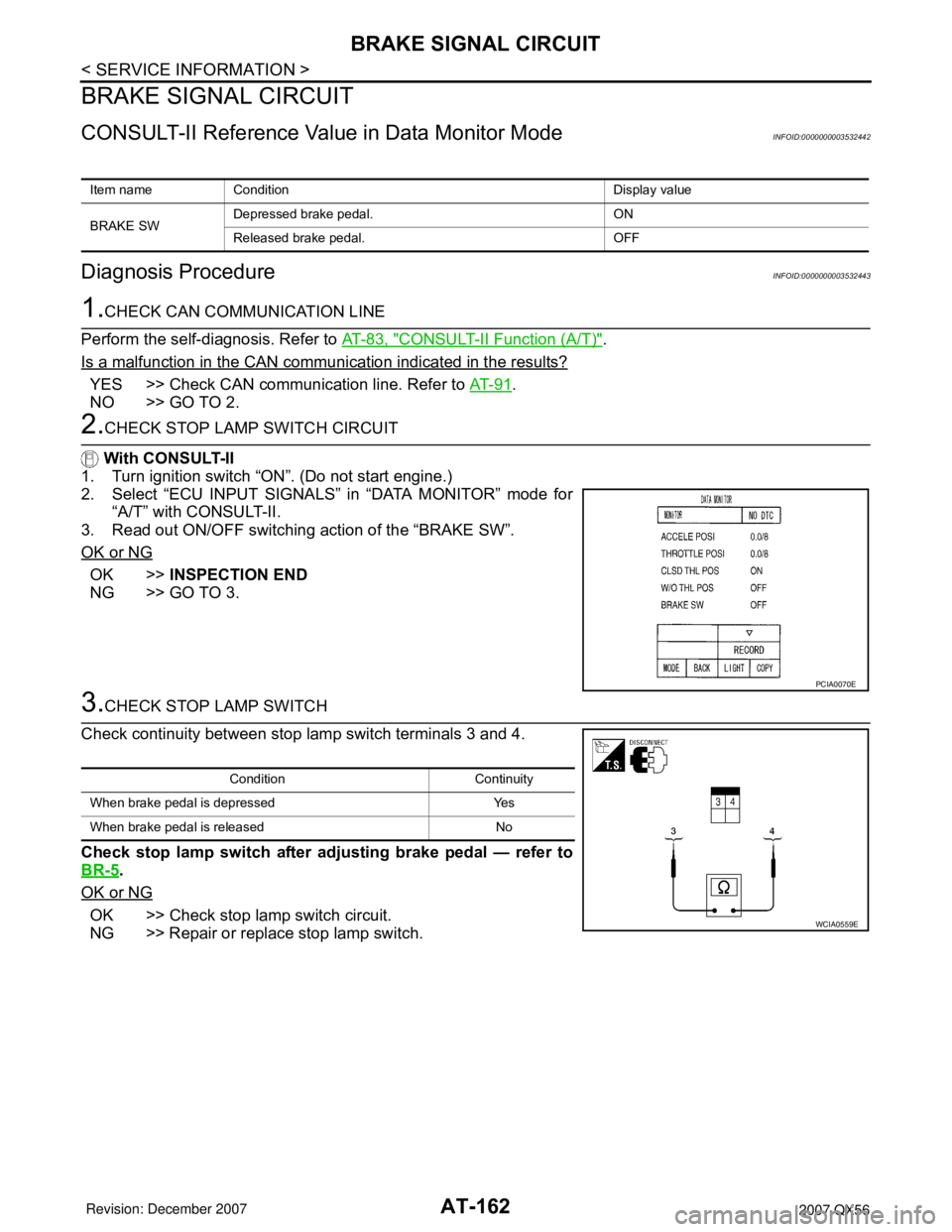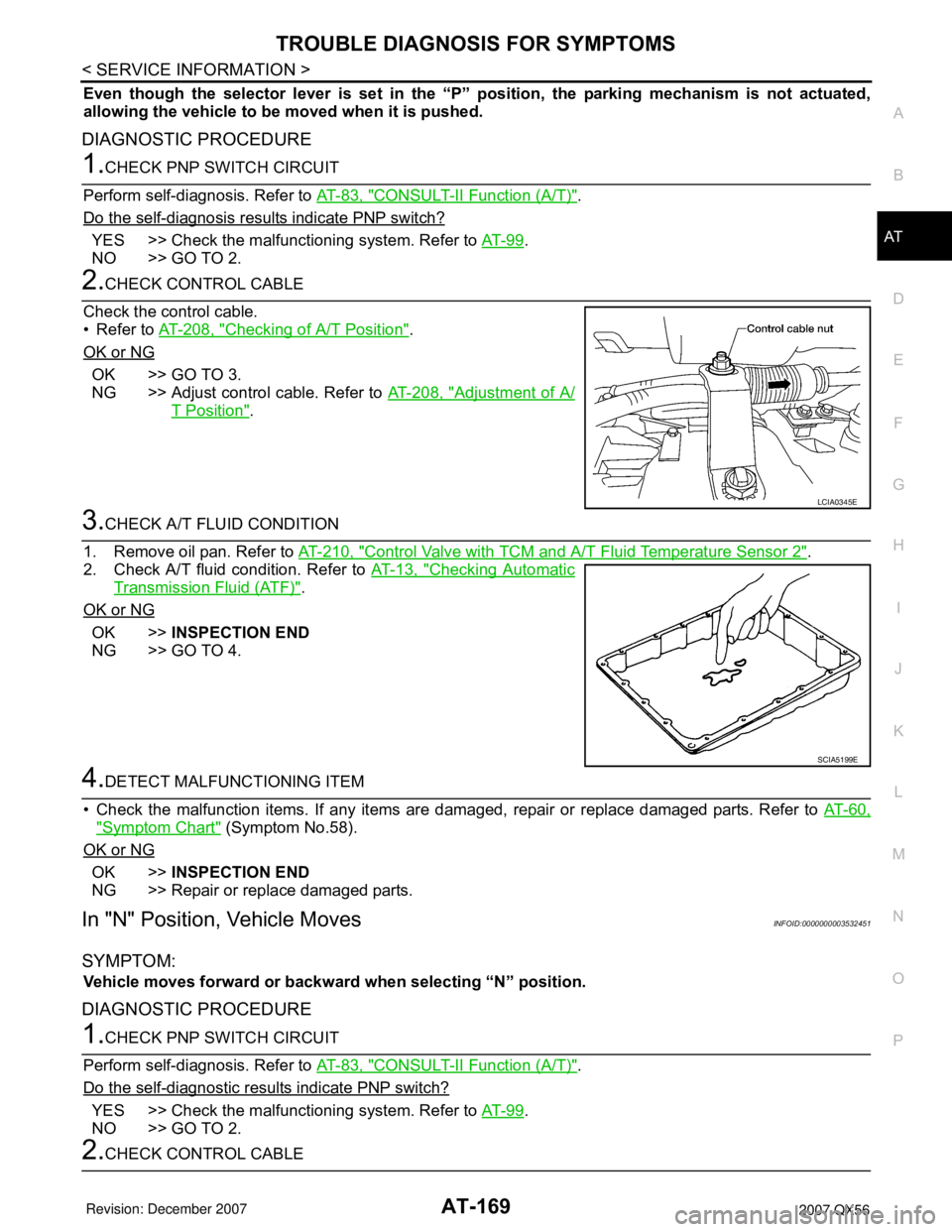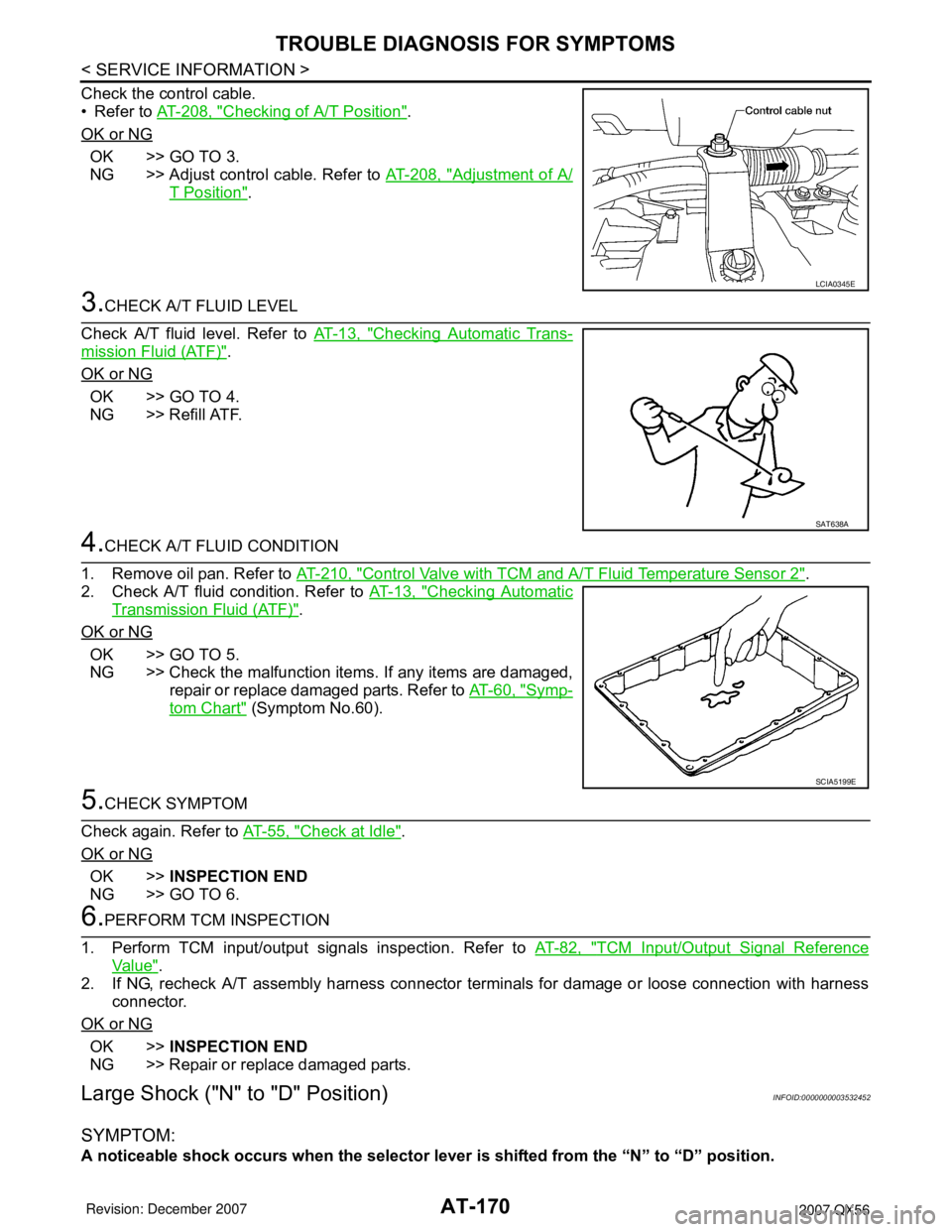air condition INFINITI QX56 2007 Factory Repair Manual
[x] Cancel search | Manufacturer: INFINITI, Model Year: 2007, Model line: QX56, Model: INFINITI QX56 2007Pages: 3061, PDF Size: 64.56 MB
Page 227 of 3061

DTC P1846 ATF PRESSURE SWITCH 6
AT-157
< SERVICE INFORMATION >
D
E
F
G
H
I
J
K
L
MA
B
AT
N
O
P
1. Start the engine.
2. Select “ECU INPUT SIGNALS” or “MAIN SIGNALS” in “DATA
MONITOR” mode for “A/T” with CONSULT-II.
3. Drive vehicle in the “D” position (2nd ⇒ 3rd gear), and confirm
the ON/OFF actuation of the “ATF PRES SW 6”.
OK or NG
OK >> GO TO 4.
NG >> GO TO 2.
2.CHECK TCM POWER SUPPLY AND GROUND CIRCUIT
Check TCM power supply and ground circuit. Refer to AT-158
.
OK or NG
OK >> GO TO 3.
NG >> Repair or replace damaged parts.
3.DETECT MALFUNCTIONING ITEM
Check the following items:
• The A/T assembly harness connector pin terminals for damage or loose connection with harness connector.
OK or NG
OK >> Replace the control valve with TCM. Refer to AT-210, "Control Valve with TCM and A/T Fluid Tem-
perature Sensor 2".
NG >> Repair or replace damaged parts.
4.CHECK DTC
Perform “DTC Confirmation Procedure”.
• Refer to AT-156, "
DTC Confirmation Procedure".
OK or NG
OK >>INSPECTION END
NG >> GO TO 2.
Item name Condition Display value
ATF PRES SW
6High and low reverse clutch engaged. Re-
fer to AT- 2 0
.ON
High and low reverse clutch disengaged.
Refer to AT- 2 0
.OFFPCIA0067E
Page 231 of 3061

CLOSED THROTTLE POSITION AND WIDE OPEN THROTTLE POSITION CIR-
CUIT
AT-161
< SERVICE INFORMATION >
D
E
F
G
H
I
J
K
L
MA
B
AT
N
O
P
CLOSED THROTTLE POSITION AND WIDE OPEN THROTTLE POSITION
CIRCUIT
CONSULT-II Reference Value in Data Monitor ModeINFOID:0000000003532440
Diagnosis ProcedureINFOID:0000000003532441
1.CHECK CAN COMMUNICATION LINE
Perform the self-diagnosis. Refer to AT-83, "
CONSULT-II Function (A/T)".
Is a malfunction in the CAN communication indicated in the results?
YES >> Check CAN communication line. Refer to AT- 9 1.
NO >> GO TO 2.
2.CHECK THROTTLE POSITION SIGNAL CIRCUIT
With CONSULT-II
1. Turn ignition switch “ON”. (Do not start engine.)
2. Select “ECU INPUT SIGNALS” in “DATA MONITOR” mode for
“A/T” with CONSULT-II.
3. Depress accelerator pedal and read out the value of “CLSD THL
POS” and “W/O THL POS”.
OK or NG
OK >>INSPECTION END
NG >> Check the following items. If NG, repair or replace damaged parts.
• Perform the self-diagnosis for “ENGINE” with CONSULT-II.
• Open circuit or short to ground or short to power in harness or connectors.
• Pin terminals for damage or loose connection with harness connector.
Item name Condition Display value
CLSD THL POSReleased accelerator pedal. ON
Fully depressed accelerator pedal. OFF
W/O THL POSFully depressed accelerator pedal. ON
Released accelerator pedal. OFF
Accelerator Pedal OperationMonitor Item
CLSD THL POS W/O THL POS
Released ON OFF
Fully depressed OFF ON
PCIA0070E
Page 232 of 3061

AT-162
< SERVICE INFORMATION >
BRAKE SIGNAL CIRCUIT
BRAKE SIGNAL CIRCUIT
CONSULT-II Reference Value in Data Monitor ModeINFOID:0000000003532442
Diagnosis ProcedureINFOID:0000000003532443
1.CHECK CAN COMMUNICATION LINE
Perform the self-diagnosis. Refer to AT-83, "
CONSULT-II Function (A/T)".
Is a malfunction in the CAN communication indicated in the results?
YES >> Check CAN communication line. Refer to AT- 9 1.
NO >> GO TO 2.
2.CHECK STOP LAMP SWITCH CIRCUIT
With CONSULT-II
1. Turn ignition switch “ON”. (Do not start engine.)
2. Select “ECU INPUT SIGNALS” in “DATA MONITOR” mode for
“A/T” with CONSULT-II.
3. Read out ON/OFF switching action of the “BRAKE SW”.
OK or NG
OK >>INSPECTION END
NG >> GO TO 3.
3.CHECK STOP LAMP SWITCH
Check continuity between stop lamp switch terminals 3 and 4.
Check stop lamp switch after adjusting brake pedal — refer to
BR-5
.
OK or NG
OK >> Check stop lamp switch circuit.
NG >> Repair or replace stop lamp switch.
Item name Condition Display value
BRAKE SWDepressed brake pedal. ON
Released brake pedal. OFF
PCIA0070E
Condition Continuity
When brake pedal is depressed Yes
When brake pedal is released No
WCIA0559E
Page 234 of 3061

AT-164
< SERVICE INFORMATION >
TOW MODE SWITCH
Diagnosis Procedure
INFOID:0000000003532446
1.CHECK CAN COMMUNICATION LINE
Perform the self-diagnosis. Refer to AT-83, "
CONSULT-II Function (A/T)".
Is any malfunction in the CAN communication indicated in the results?
YES >> Check CAN communication line. Refer to AT- 9 1.
NO >> GO TO 2.
2.CHECK POWER SOURCE
1. Turn ignition switch “ON”. (Do not start engine.)
2. Check the voltage between tow mode switch connector M67 ter-
minal 1 and ground.
OK or NG
OK >>INSPECTION END
NG >> GO TO 3.
3.CHECK TOW MODE SWITCH
1. Turn ignition switch “OFF”.
2. Disconnect tow mode switch connector.
3. Check continuity between tow mode switch terminals 1 and 2.
OK or NG
OK >> GO TO 4.
NG >> Repair or replace tow mode switch.
4.DETECT MALFUNCTIONING ITEM
Check the following items. If any items are damaged, repair or replace damaged parts.
• Harness for short or open between combination meter connector terminal 35 and tow mode switch connec-
tor terminal 1.
• Harness for short or open between tow mode switch connector terminal 2 and ground.
OK or NG
OK >> GO TO 5.
NG >> Repair or replace damaged parts.
5.CHECK COMBINATION METER
Check the combination meter. Refer to DI-15, "
How to Proceed with Trouble Diagnosis".
OK or NG
OK >>INSPECTION END
NO >> Repair or replace damaged parts.
ConditionTo w m o d e
switchData (Approx.)
When ignition switch is turned to “ON”ON 0V
OFF Battery voltage
SCIA5156E
Condition Continuity
Tow mode switch “ON” Yes
Tow mode switch “OFF” No
SCIA5584E
Page 239 of 3061

TROUBLE DIAGNOSIS FOR SYMPTOMS
AT-169
< SERVICE INFORMATION >
D
E
F
G
H
I
J
K
L
MA
B
AT
N
O
P
Even though the selector lever is set in the “P” position, the parking mechanism is not actuated,
allowing the vehicle to be moved when it is pushed.
DIAGNOSTIC PROCEDURE
1.CHECK PNP SWITCH CIRCUIT
Perform self-diagnosis. Refer to AT-83, "
CONSULT-II Function (A/T)".
Do the self-diagnosis results indicate PNP switch?
YES >> Check the malfunctioning system. Refer to AT- 9 9.
NO >> GO TO 2.
2.CHECK CONTROL CABLE
Check the control cable.
• Refer to AT-208, "
Checking of A/T Position".
OK or NG
OK >> GO TO 3.
NG >> Adjust control cable. Refer to AT-208, "
Adjustment of A/
T Position".
3.CHECK A/T FLUID CONDITION
1. Remove oil pan. Refer to AT-210, "
Control Valve with TCM and A/T Fluid Temperature Sensor 2".
2. Check A/T fluid condition. Refer to AT-13, "
Checking Automatic
Transmission Fluid (ATF)".
OK or NG
OK >>INSPECTION END
NG >> GO TO 4.
4.DETECT MALFUNCTIONING ITEM
• Check the malfunction items. If any items are damaged, repair or replace damaged parts. Refer to AT-60,
"Symptom Chart" (Symptom No.58).
OK or NG
OK >>INSPECTION END
NG >> Repair or replace damaged parts.
In "N" Position, Vehicle MovesINFOID:0000000003532451
SYMPTOM:
Vehicle moves forward or backward when selecting “N” position.
DIAGNOSTIC PROCEDURE
1.CHECK PNP SWITCH CIRCUIT
Perform self-diagnosis. Refer to AT-83, "
CONSULT-II Function (A/T)".
Do the self-diagnostic results indicate PNP switch?
YES >> Check the malfunctioning system. Refer to AT- 9 9.
NO >> GO TO 2.
2.CHECK CONTROL CABLE
LCIA0345E
SCIA5199E
Page 240 of 3061

AT-170
< SERVICE INFORMATION >
TROUBLE DIAGNOSIS FOR SYMPTOMS
Check the control cable.
• Refer to AT-208, "
Checking of A/T Position".
OK or NG
OK >> GO TO 3.
NG >> Adjust control cable. Refer to AT-208, "
Adjustment of A/
T Position".
3.CHECK A/T FLUID LEVEL
Check A/T fluid level. Refer to AT-13, "
Checking Automatic Trans-
mission Fluid (ATF)".
OK or NG
OK >> GO TO 4.
NG >> Refill ATF.
4.CHECK A/T FLUID CONDITION
1. Remove oil pan. Refer to AT-210, "
Control Valve with TCM and A/T Fluid Temperature Sensor 2".
2. Check A/T fluid condition. Refer to AT-13, "
Checking Automatic
Transmission Fluid (ATF)".
OK or NG
OK >> GO TO 5.
NG >> Check the malfunction items. If any items are damaged,
repair or replace damaged parts. Refer to AT-60, "
Symp-
tom Chart" (Symptom No.60).
5.CHECK SYMPTOM
Check again. Refer to AT-55, "
Check at Idle".
OK or NG
OK >>INSPECTION END
NG >> GO TO 6.
6.PERFORM TCM INSPECTION
1. Perform TCM input/output signals inspection. Refer to AT-82, "
TCM Input/Output Signal Reference
Va l u e".
2. If NG, recheck A/T assembly harness connector terminals for damage or loose connection with harness
connector.
OK or NG
OK >>INSPECTION END
NG >> Repair or replace damaged parts.
Large Shock ("N" to "D" Position)INFOID:0000000003532452
SYMPTOM:
A noticeable shock occurs when the selector lever is shifted from the “N” to “D” position.
LCIA0345E
SAT638A
SCIA5199E
Page 242 of 3061

AT-172
< SERVICE INFORMATION >
TROUBLE DIAGNOSIS FOR SYMPTOMS
- Oil pump assembly. Refer to AT-258, "Oil Pump".
OK or NG
OK >> GO TO 8.
NG >> Repair or replace damaged parts.
7.DETECT MALFUNCTIONING ITEM
1. Check control valve with TCM. Refer to AT-210, "
Control Valve with TCM and A/T Fluid Temperature Sen-
sor 2".
2. Disassemble A/T. Refer to AT-240, "
Disassembly".
3. Check the following items:
- Oil pump assembly. Refer to AT-258, "
Oil Pump".
- Power train system. Refer to AT-240, "
Disassembly".
- Transmission case. Refer to AT-240, "
Disassembly".
OK or NG
OK >> GO TO 8.
NG >> Repair or replace damaged parts.
8.CHECK A/T FLUID CONDITION
1. Remove oil pan. Refer to AT-210, "
Control Valve with TCM and A/T Fluid Temperature Sensor 2".
2. Check A/T fluid condition. Refer to AT-13, "
Checking Automatic
Transmission Fluid (ATF)".
OK or NG
OK >> GO TO 10.
NG >> GO TO 9.
9.DETECT MALFUNCTIONING ITEM
• Check the malfunction items. If any items are damaged, repair or replace damaged parts. Refer to AT-60,
"Symptom Chart" (Symptom No.1).
OK or NG
OK >> GO TO 10.
NG >> Repair or replace damaged parts.
10.CHECK SYMPTOM
Check again. Refer to AT-55, "
Check at Idle".
OK or NG
OK >>INSPECTION END
NG >> GO TO 11.
11 .PERFORM TCM INSPECTION
1. Perform TCM input/output signals inspection. Refer to AT-82, "
TCM Input/Output Signal Reference
Va l u e".
2. If NG, recheck A/T assembly harness connector terminals for damage or loose connection with harness
connector.
OK or NG
OK >>INSPECTION END
NG >> Repair or replace damaged parts.
Vehicle Does Not Creep Backward in "R" PositionINFOID:0000000003532453
SYMPTOM:
The vehicle does not creep in the “R” position. Or an extreme lack of acceleration is observed.
DIAGNOSTIC PROCEDURE
SCIA5199E
Page 244 of 3061

AT-174
< SERVICE INFORMATION >
TROUBLE DIAGNOSIS FOR SYMPTOMS
Check the line pressure with the engine idling. Refer to AT-51,
"Inspections Before Trouble Diagnosis".
OK or NG
OK >> GO TO 9.
NG - 1 >> Line pressure high. GO TO 7.
NG - 2 >> Line pressure low. GO TO 8.
7.DETECT MALFUNCTIONING ITEM
1. Check control valve with TCM. Refer to AT-210, "
Control Valve with TCM and A/T Fluid Temperature Sen-
sor 2".
2. Disassemble A/T. Refer to AT-240, "
Disassembly".
3. Check the following items:
- Oil pump assembly. Refer to AT-258, "
Oil Pump".
OK or NG
OK >> GO TO 9.
NG >> Repair or replace damaged parts.
8.DETECT MALFUNCTIONING ITEM
1. Check control valve with TCM. Refer to AT-210, "
Control Valve with TCM and A/T Fluid Temperature Sen-
sor 2".
2. Disassemble A/T. Refer to AT-240, "
Disassembly".
3. Check the following items:
- Oil pump assembly. Refer to AT-258, "
Oil Pump".
- Power train system. Refer to AT-240, "
Disassembly".
- Transmission case. Refer to AT-240, "
Disassembly".
OK or NG
OK >> GO TO 9.
NG >> Repair or replace damaged parts.
9.CHECK A/T FLUID CONDITION
1. Remove oil pan. Refer to AT-210, "
Control Valve with TCM and A/T Fluid Temperature Sensor 2".
2. Check A/T fluid condition. Refer to AT-51, "
Inspections Before
Trouble Diagnosis".
OK or NG
OK >> GO TO 10.
NG >> GO TO 13.
10.DETECT MALFUNCTIONING ITEM
• Check the malfunction items. If any items are damaged, repair or replace damaged parts. Refer to AT-60,
"Symptom Chart" (Symptom No.43).
OK or NG
OK >> GO TO 11.
NG >> Repair or replace damaged parts.
11 .CHECK SYMPTOM
Check again. Refer to AT-55, "
Check at Idle".
OK or NG
SAT494G
SCIA5199E
Page 246 of 3061

AT-176
< SERVICE INFORMATION >
TROUBLE DIAGNOSIS FOR SYMPTOMS
4.CHECK STALL TEST
Check stall revolution with selector lever in “D” position. Refer to AT-
51, "Inspections Before Trouble Diagnosis".
OK or NG
OK >> GO TO 5.
NG >> GO TO 7.
5.CHECK LINE PRESSURE
Check line pressure at idle with selector lever in “D” position. Refer
to AT-51, "
Inspections Before Trouble Diagnosis".
OK or NG
OK >> GO TO 8.
NG - 1 >> Line pressure high. GO TO 6.
NG - 2 >> Line pressure low. GO TO 7.
6.DETECT MALFUNCTIONING ITEM
1. Check control valve with TCM. Refer to AT-210, "
Control Valve with TCM and A/T Fluid Temperature Sen-
sor 2".
2. Disassemble A/T. Refer to AT-240, "
Disassembly".
3. Check the following items:
- Oil pump assembly. Refer to AT-258, "
Oil Pump".
OK or NG
OK >> GO TO 8.
NG >> Repair or replace damaged parts.
7.DETECT MALFUNCTIONING ITEM
1. Check control valve with TCM. Refer to AT-210, "
Control Valve with TCM and A/T Fluid Temperature Sen-
sor 2".
2. Disassemble A/T. Refer to AT-240, "
Disassembly".
3. Check the following items:
- Oil pump assembly. Refer to AT-258, "
Oil Pump".
- Power train system. Refer to AT-240, "
Disassembly".
- Transmission case. Refer to AT-240, "
Disassembly".
OK or NG
OK >> GO TO 8.
NG >> Repair or replace damaged parts.
8.CHECK A/T FLUID CONDITION
1. Remove oil pan. Refer to AT-210, "
Control Valve with TCM and A/T Fluid Temperature Sensor 2".
SAT493G
SAT494G
Page 247 of 3061

TROUBLE DIAGNOSIS FOR SYMPTOMS
AT-177
< SERVICE INFORMATION >
D
E
F
G
H
I
J
K
L
MA
B
AT
N
O
P
2. Check A/T fluid condition. Refer to AT-51, "Inspections Before
Trouble Diagnosis".
OK or NG
OK >> GO TO 9.
NG >> GO TO 12.
9.DETECT MALFUNCTIONING ITEM
• Check the malfunction items. If any items are damaged, repair or replace damaged parts. Refer to AT-60,
"Symptom Chart" (Symptom No.43).
OK or NG
OK >> GO TO 10.
NG >> Repair or replace damaged parts.
10.CHECK SYMPTOM
Check again. Refer to AT-55, "
Check at Idle".
OK or NG
OK >>INSPECTION END
NG >> GO TO 11.
11 .PERFORM TCM INSPECTION
1. Perform TCM input/output signals inspection. Refer to AT-82, "
TCM Input/Output Signal Reference
Va l u e".
2. If NG, recheck A/T assembly harness connector terminals for damage or loose connection with harness
connector.
OK or NG
OK >>INSPECTION END
NG >> Repair or replace damaged parts.
12.DETECT MALFUNCTIONING ITEM
• Check the malfunction items. If any items are damaged, repair or replace damaged parts. Refer to AT-60,
"Symptom Chart" (Symptom No.43).
OK or NG
OK >> GO TO 10.
NG >> Repair or replace damaged parts.
Vehicle Cannot Be Started from D1INFOID:0000000003532455
SYMPTOM:
Vehicle cannot be started from D1 on cruise test - Part 1.
DIAGNOSTIC PROCEDURE
1.CONFIRM THE SYMPTOM
Check if vehicle creeps in “R” position.
OK or NG
OK >> GO TO 2.
NG >> Refer to AT-172, "
Vehicle Does Not Creep Backward in "R" Position".
2.CHECK SELF-DIAGNOSTIC RESULTS
Perform self-diagnosis. Refer to AT-83, "
CONSULT-II Function (A/T)".
Is any malfunction detected by self-diagnostic results?
YES >> Check the malfunctioning system.
SCIA5199E